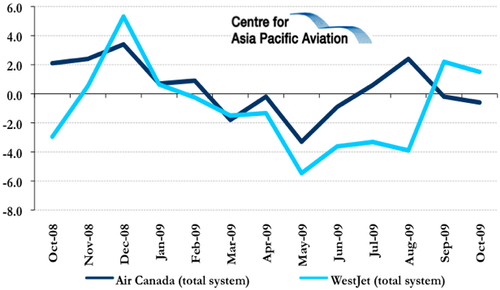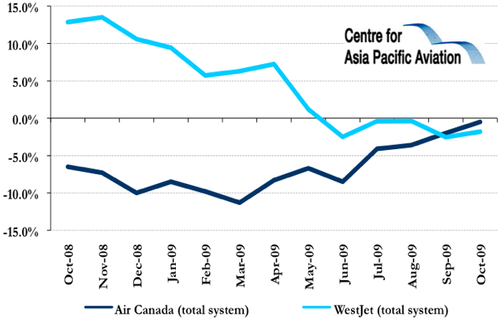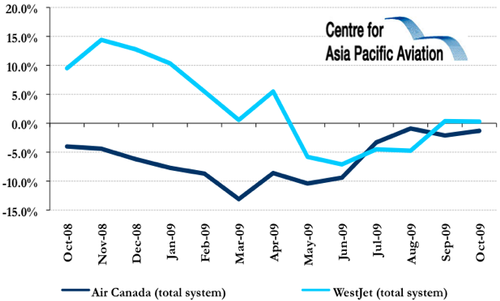Air Canada and WestJet still (marginally) reducing capacity in challenging operating environment
Both Air Canada and WestJet reduced capacity in Oct-2009, as the Canadian airlines continue to face challenging operating conditions, characterised by economic weakness, soft travel demand and aggressive competitor pricing.
WestJet seeing indications that RASM declines are levelling off
However, in more positive news, WestJet, upon the release of its Oct-2009 traffic results, stated in the past six to eight weeks it has "seen indications that RASM declines have levelled off", with the LCC adding that it is "seeing signs of improvement from what we were previously experiencing".
CEO, Sean Durfy, added, "while it is still too early to predict the strength or speed of a potential recovery, we feel optimistic about the future and the continued success of our airline."
WestJet traffic highlights: Oct-2009
|
|
Oct-2009 |
% Change |
|---|---|---|
|
Traffic RPMs (bill) |
1.1 |
+0.3% |
|
Capacity ASMs (bill) |
1.4 |
-1.8% |
|
Load factor (%) |
77.3% |
+1.5 ppts |
Second consecutive month of load factor improvements for WestJet
WestJet, which has been one of the few profitable airlines in North America over the past 12 months and was once again profitable in 3Q2009, also reported an improvement in Oct-2009 load factor, up 1.5 ppts to 77.3%, for the second consecutive year-on-year load factor increase (prior to this, the carrier had reported seven consecutive months of load factor reduction).
This prompted Mr Durfy to state that the carrier is "encouraged" by its load factor performance in the month.
WestJet and Air Canada PLF (year-on-year growth): Oct-2008 to Oct-2009
Seeing "more strength in early bookings: WestJet
The LCC added that it has been seeing "more strength in both our business and sun destination bookings". The carrier also stated it is "pleased" with early bookings of its 11 new Southern destinations (nine of which have already been launched).
WestJet is finally reducing capacity, after a period of steady growth in 2H2009 and early 2010, with Air Canada now heading back towards capacity growth, after well over a year of contraction.
WestJet and Air Canada capacity (ASMs) growth: Oct-2008 to Oct-2009
Air Canada and WestJet RPM growth: Oct-2008 to Oct-2009
Air Canada's load factors stronger than WestJet's
Air Canada reported a system load factor of 79.6% in Oct-2009 on a consolidated basis, a 0.6 ppt year-on-year reduction, while system traffic (RPMs) declined 1.3%, on a 0.5% capacity (ASMs) reduction. Air Canada has reduced capacity every month in the past year, with the largest contraction of 11.3% experienced in May-2009.
Air Canada traffic highlights: Oct-2009
|
|
Oct-2009 |
% Change |
|---|---|---|
|
Traffic RPMs (mill) US trans-border |
3,850 1,258 534 |
-1.3% -1.8% -7.3% |
|
Capacity ASMs (mill) US trans-border |
4,835 1,563 731 |
-0.5% -1.9% -3.2% |
|
Load factor (%) US trans-border |
79.6% 80.5% 73.1% |
-0.6 ppts +0.1 ppts -3.2 ppts |
Air Canada's load factors have been stronger than WestJet's every month for the past eight months, with the network carrier reporting higher load factors than WestJet in all but one of the past 13 months.
WestJet and Air Canada PLF (%): Oct-2008 to Oct-2009
According to Air Canada President and CEO, Calin Rovinescu, the carrier's load factor result is "close to last year's record load factor for the same month and underscores our continued disciplined approach to managing capacity".
In other Air Canada news, ACE Aviation Holdings this month confirmed it is no longer the majority shareholder in Air Canada after its equity stake in the carrier fell from 75% to 27% following the carrier's share issue.



